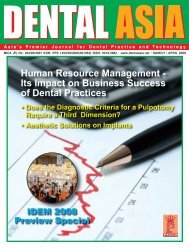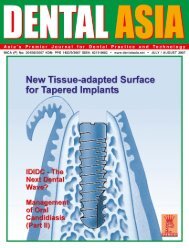Download - Dental Asia
Download - Dental Asia
Download - Dental Asia
Create successful ePaper yourself
Turn your PDF publications into a flip-book with our unique Google optimized e-Paper software.
CLINICALFEATURE<br />
mean Vita Easyshade scores at baseline, post-staining and<br />
post product usage. The chromogenic “meal” consisted of:<br />
• 3 ounces of red grape juice or red wine<br />
• 3 ounces of blueberry pie<br />
• one piece of milk chocolate<br />
• 4-6 ounces of coffee or tea<br />
The brushless dentifrice that was tested is a commercially<br />
available, non-prescription product that requires no post-use<br />
rinsing. Its active ingredients include Dicalcium Phosphate<br />
Dihydrate, Urea Hydrogen Peroxide, and Calprox. The<br />
instructions for use indicate that a small drop of the product be<br />
placed on the anterior teeth or the tongue and smoothed over<br />
the remaining anterior teeth with the tongue and the lips.<br />
Results and Discussion<br />
Tooth shade was calculated by ranking the Vita Classic Shade<br />
guide according to the degree of brightness as recommended<br />
The measured results indicate<br />
that eating a chromogenic<br />
“meal” caused the<br />
accumulated food induced<br />
stains to darken the subjects’<br />
tooth shades by<br />
approximately 2 Vita tabs<br />
Statistical analysis by the t-test comparing:<br />
1. The Baseline data with the Post Stain Accumulation data<br />
indicated significant differences (p≥ 0.05) showing that<br />
chromogenic foods can indeed induce dental stains, darkening<br />
the appearance of the teeth.<br />
2. The Post Stain Accumulation data with the Post Product<br />
Usage data indicated significant differences (p≥ 0.05) showing<br />
that SuperSmile Quikee, the product under investigation, does<br />
remove dental stains acquired as a result of eating<br />
chromogenic foods.<br />
3. The Baseline data with the Post Product Usage data<br />
indicated significant differences (p≥ 0.05) showing that the<br />
product under investigation does remove previously acquired<br />
dental stains.<br />
Figure 4 The Easyshade’s CPU analyzes the spectrometer data, determining<br />
a shade match to Vita Classical or 3D systems, and displays the results on a<br />
touch screen<br />
by the manufacturer, assigning a numerical value to each tab<br />
and calculating the number of tabs as described by Manupome<br />
and Petty (2004).<br />
A summary of the changes in tooth shade during the study is<br />
provided in the following table:<br />
The measured results indicate that eating a chromogenic<br />
“meal” caused the accumulated food-induced stains to darken<br />
the subjects’ tooth shades by approximately 2 Vita tabs (Fig 5).<br />
The Baseline Vita Easyshade data for 480 (40 X 12) teeth in<br />
the study was 4.37 (SD±2.37), corresponding to a shade<br />
between Vita Classic tabs D2-A2.<br />
The Post Stain Accumulation Vita Easyshade data for 480<br />
(40 X 12) teeth in the study was 6.56 (SD±3.03), corresponding<br />
to a shade between Vita Classic tabs C1-C2. Statistical<br />
analysis by the t-test showed significant differences, indicating<br />
that eating a chromogenic diet as described above does, in<br />
fact, induce staining of teeth.<br />
The Post Product Usage Vita Easyshade data for 480 (40 X<br />
12) teeth in the study was 3.72(SD±2.33), corresponding to a<br />
shade between Vita Classic tabs B2-D2.<br />
Figure 5 Chromogenic ‘meal’ accumulated food-induced stain to be<br />
darkened<br />
32 <strong>Dental</strong> <strong>Asia</strong> • May / June 2008





